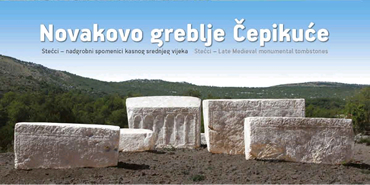Znamenitosti
Pretpovijest
Gomile – Tumuli
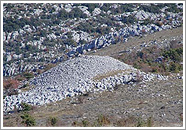
Gomile se na ovom i širem području javljaju kao grobni spomenici te kao dio fortifikacijskog sustava obzidanih naselja i ritualnih prostora. Smještene su uvijek u blizini gradinskih lokaliteta, na strateškim mjestima, uz komunikacije, iznad polja i uglavnom po brdskim obodima. Najveća nekropola gomila, ne samo na prostoru Dubrovačkog primorja, nego i na čitavom južnojadranskom prostoru, nalazi se između naselja Visočani i Lisac gdje je evidentirano 48 gomila.
Antika/Kasna antika
Lapidarij u vrtu Franjevačkog samostana u Slanomu
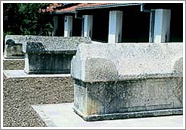
Lokalitet franjevačkog samostana sv. Jeronima, ubiciran je na arheološkoj karti početkom XX. st.
Tada su u vrtu zvanom „U đardinu“ pronađena četiri ranokršćanska sarkofaga
i dva groba.
Predromanika
Crkva «Rotonda» u Ošljem
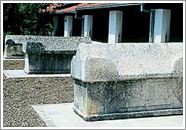
Ostatci crkve na padini brda, sjeverno od sela Ošlje, na lokalitetu zvanom Bijela lokva. Titular crkve je nepoznat, a mještani je, osim „Rotonda“, nazivaju i „Banovi dvori“ i „Mirine“. Tlocrt joj je kružno izveden, a oko njega je raspoređeno osam polukružnih apsida s vanjske i unutrašnje strane. Ima tlocrt osmerolista s pravokutnim narteksom na zapadnoj strani, na čijem se kraju uzdizao zvonik. Zasad je, na južnojadranskom primorju, crkva usamljeni primjer predromaničkog korpusa osmerolisnog tlocrta, nad kojim se nekada uzdizala kupola. Crkva se datira u IX./X. st.
Stećci
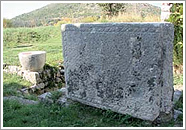
Tajnoviti spomenici naše kulturno povijesne baštine koji nastaju od kraja XIII.do sredine XVI. st., kamena su obilježja na posljednjim počivalištima mrtvih. Postavljani su oko crkava, srednjovjekovnih groblja, na pretpovijesnim gomilama, ali najčešće uz putove. Neki su ukrašeni prizorima iz života, viticama, palmetama, motivima turnira, lova, kola, ljudskim likovima… Tipološki se dijele na sljemenjak, sanduk i ploču. U Dubrovačkom primorju sačuvano je 26 nekropola stećaka.
Samostan i crkva sv. Jeronima u Slanomu
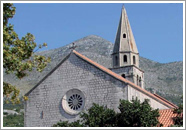
Nalazi se južno od naselja, na dominantnom mjestu s kojega se kontrolira čitav zaljev, morski kanal i okolne uzvisine, a od naselja ga dijeli put koji vodi od obale do Kneževa dvora. Dubrovačka Republika odmah nakon stjecanja Dubrovačkog primorja 1399. g. daje dozvolu bosanskim franjevcima da sagrade samostan zbog suzbijanja bogumilstva. Samostan je dala sagraditi dubrovačka plemićka obitelj Lisac, a crkvu sv. Jeronima, obitelj Gradić 1420. g., o čemu svjedoči kamena ploča s natpisom u heksametru koji je uzidan na pročelju crkve. On govori o donatorima crkve, obitelji Gradić, otac Junije i sinovi Matej i Marin. Arheološkim istraživanjima pronađeni su ostatci prve mnogo manje crkve od današnje.
Knežev dvor
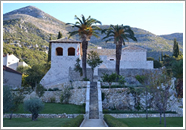
Knežev dvor smješten je u sjeveroistočnom dijelu naselja Slano uz glavnu prometnicu. Speci?čne funkcije stan kneza, upravno i administrativno središte novostečenog teritorija Primorja (1399. g.), uvjetovale su značaj izgradnje sklopa, što je vidljivo u prostornoj shemi visokog zatvorenog bloka kojiizgledom više podsjeća na utvrđeno gospodarstvo nego na reprezentativnu stambenu građevinu.
Crkva sv. Vlaha
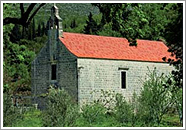
Nalazi se u istočnom dijelu naselja Slano uz put koji vodi u Banju. To je jednobrodna gra-đevina s pravokutnom apsidom. Unutrašnjost broda natkriva zrcalni svod, a u svetištu bačvasti. Glavno pročelje rastvoreno je portalom s otvorenim zabatom, ukrašenim stiliziranom palmetom. Na nadvratniku portala je latinski natpis koji datira izgradnju crkve (1758 g.)
" ADNI MDCCLVIII HAS TIBI DIVE BLASI LETUNICH STRUXERAT AEDES SACRAVITQ(VE) SUO CUM GREACE POSTOR OPUS." Svetištu je s istočne strane prigrađena dvokatna zgrada župnog dvora.
Crkva sv. Roka
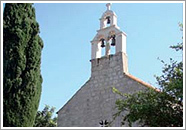
Smještena je u sjeverozapadnom dijelu naselja Grgurići. Tlocrtno je izduženi pravokutnik s užim pravokutnim svetištem na koje se s južne strane veže sakristija. Na zapadnoj je strani broda drveni kor na kojemu je donatorski natpis Tonka, sina Marka Gradića koji je crkvu posvetio Sv. Roku i Sv. Vračima (Kuzmi i Da-mjanu) kao zavjet protiv kuge, što je u Slanome i okolici harala oko 1527. g. U crkvi sv. Roka nalazi se oltarska pala koju je naslikao nizozemski slikar Marten de Vos krajem XVI. st. s ikonografskim prikazom zavjetnih svetaca.
Ljetnikovac Ohmučević
Nalazi se u sjeveroistočnom dijelu naselja Slano. Obitelj Ohmučević spominje se u Slanom već od XV. st. Oni su najstariji, najbrojniji i najpoznatiji rod ovog prostora. Prema predaji naselili su se u Slanome 1300. g. pod imenom Grgurići. Za vrijeme Dubrovačke Republike bili su vrsni pomorci i brodovlasnici.
Graničnik
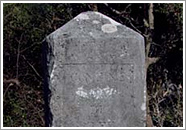
Graničnik, kameni-monolit, obilježje na sjeverozapadnom dijelu teritorija nekadašnje Dubrovačke Republike, nalazi se uz rub ceste koja vodi od Imotice prema starom Neumu. Na njemu je upisan natpis CONFINE TURCO KLEP 1728. g. Postavljen je nakon Tursko-mletačko-austrijskog rata 1715. - 1718. g. kad je mirom u Požarevcu, između zaraćenih strana, precizirano da područje Dubrovačke Republike zadrži izravnu teritorijalnu vezu s Turskom. Na taj su način ostvarena nastojanja Republike da između Venecije i Dubrovnika zadrži turske enklave (Neum, Klek i Sutorinu), što je osiguravalo nesmetanu trgovinu sa zaleđem i turskim zemljama uopće.







